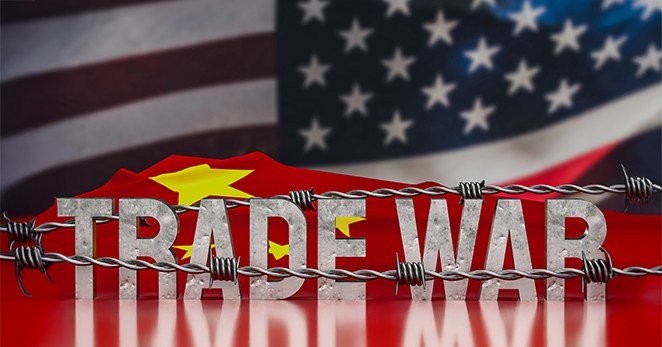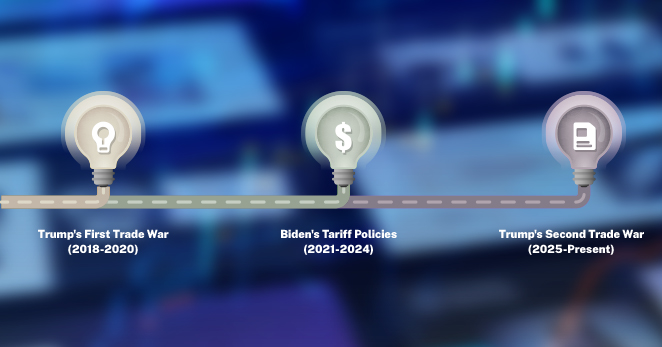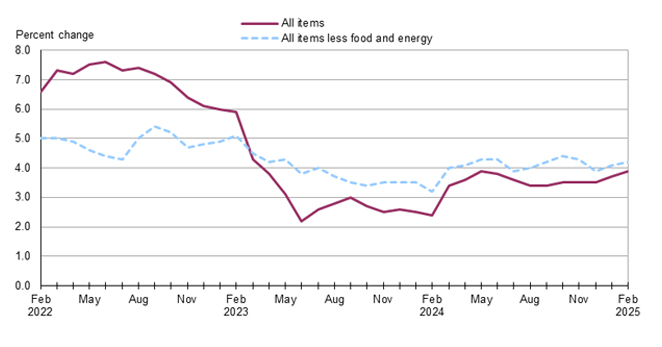
The United States and China have historically been economic rivals, but recent developments have intensified tensions into a full-blown trade war. The return of former President Donald Trump to office has reignited the tariff battle, greatly affecting businesses, markets, and global trade. As new tariffs and retaliatory measures are implemented, the uncertainty surrounding trade policies is causing disruptions in supply chains and financial markets.
How We Got Here: A Timeline of the Trade War

Trump’s First Trade War (2018-2020)
- 2018: Trump imposes sweeping tariffs on Chinese goods, citing unfair trade practices and intellectual property theft. In response, China retaliates with tariffs on American exports, particularly agricultural products like soybeans and pork.
- 2019: The two nations continue their tit-for-tat tariff exchange, with duties applied to goods ranging from electronics to automobiles.
- 2020: A partial truce is reached with the Phase One trade deal, wherein China agrees to purchase more U.S. goods in exchange for tariff relief on select products.
Biden’s Tariff Policies (2021-2024)
- 2021-2022: President Joe Biden largely maintains Trump’s tariffs but takes a more strategic approach, introducing restrictions on China’s access to semiconductor technology and tightening export controls.
- 2023-2024: Tariffs are expanded to cover Chinese electric vehicles, steel, and medical equipment, with China countering by restricting exports of critical minerals like gallium and germanium.
Trump’s Second Trade War (2025-Present)
- January 2025: Trump wins re-election and immediately announces sweeping new tariffs on Canada, Mexico, and China, citing national security concerns.
- February 2025: A 10% tariff on all Chinese imports goes into effect, with China responding by increasing tariffs on U.S. agricultural products and launching investigations into American tech companies.
- March 2025: Trump doubles the tariff rate on Chinese imports to 20% and imposes 25% duties on Canadian and Mexican goods. Retaliatory measures from all three countries ensue, triggering market instability.
Market Implications and Economic Impact

1. Impact on Financial Markets
Global stock markets have shown significant volatility due to escalating trade tensions. The uncertainty surrounding tariffs has caused major indices to fluctuate, prompting investors to seek safer assets such as gold and U.S. Treasury bonds. The technology and manufacturing sectors, which heavily depend on Chinese imports, have experienced sharp declines.
2. Effect on Businesses and Supply Chains
Many U.S. companies that depend on Chinese manufacturing are experiencing higher costs due to increased tariffs. Industries such as electronics, automobiles, and retail are being compelled to either absorb these costs or pass them on to consumers. Furthermore, supply chain disruptions are creating delays and inefficiencies, making it challenging for businesses to plan for the future.
3. Consumer Price Increases
The average American consumer is experiencing the effects of rising prices on goods imported from China. Essential items such as electronics, clothing, and household goods have all seen price increases, contributing to inflationary pressures. With additional tariffs imposed on Canada and Mexico, the cost of everyday items, including food and energy, is expected to rise even more.
4. Agricultural Sector Challenges
China’s retaliatory tariffs on U.S. agricultural products, including soybeans and corn, have once again put American farmers in a difficult position. With reduced export opportunities, many in the agricultural sector are bracing for losses, mirroring the struggles seen during Trump’s first trade war.
5. Impact on International Relations
The trade war has strained diplomatic relations between the U.S. and its trading partners. Both Canada and Mexico, important allies, have implemented their own countermeasures, which threaten the stability of the USMCA trade agreement. Meanwhile, China has been exploring alternative markets and has strengthened its trade ties with Europe, Africa, and Southeast Asia.
What’s Next?

As trade tensions continue to escalate, businesses and consumers will need to brace for prolonged economic uncertainty. The effectiveness of Trump’s aggressive tariff strategy remains to be seen, but one thing is clear: the global economy is set to experience major shifts in trade patterns and market behavior.
Investors, policymakers, and industry leaders will closely monitor the unfolding developments, while businesses may explore alternative supply chains to mitigate risks. In the coming months, negotiations and potential policy reversals could shape the trajectory of this new trade war.
Conclusion

The US-China trade tariff war has entered a new and unpredictable phase under Trump’s second term. With significant market implications, supply chain disruptions, and rising consumer costs, the economic landscape is shifting rapidly. As trade policies continue to evolve, businesses and individuals alike must stay informed and prepared for the challenges ahead.
Discover valuable market insights with the advanced tools offered by VT Markets. Sign up today!







